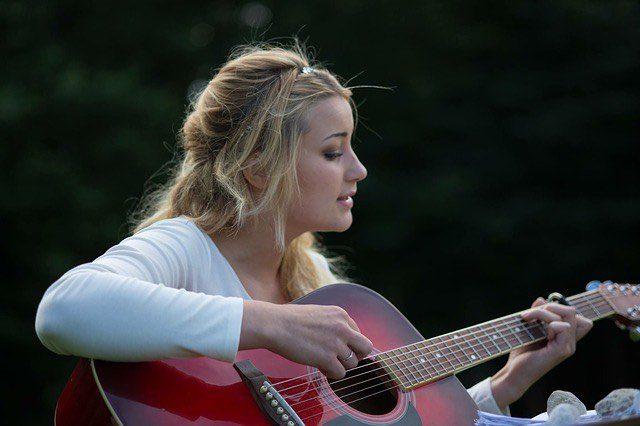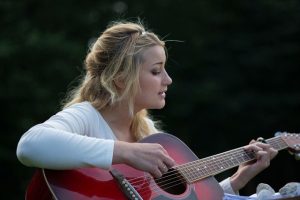With so many different terms out there describing vocal technique, it can be confusing to distinguish what all of it really means, or to apply it to your vocal study and everyday practice. Speech Level Singing is one of those terms. In this article, we’ll take a closer look at the ins and outs of Speech Level Singing, what it’s used for, when it’s used, and more. Let’s get started!
What is Speech Level Singing?
Speech Level Singing, also known as SLS, is a singing technique that emphasizes the idea that singing is just as simple as speaking. Additionally, Speech Level Singing makes a point of drawing attention to vocal registration; when singers have a “break” in their registration, (for example going from chest voice to head voice or falsetto) Speech Level Singing would say that this is a result of straining in joining different registers.
If you think about it, when we speak, we change registers all the time and rarely have issues. So, Speech Level Singing is actually a really useful tool for many different vocal styles AND speaking styles.
Speech Level Singing was originally developed by singer, actor and vocal coach, Seth Riggs, as a way to help teach the basic principle that, “if you can talk, you can sing!” Later in this article, we will look at what vocal (and speech) styles can benefit from Speech Level Singing.
Want to learn more about how to sing? Check out this helpful beginner’s tutorial that gives you 7 steps for healthier vocalization!
What’s the Difference Between Speech Level Singing and Bel Canto?
There are more similarities than differences between Speech Level Singing and Bel Canto. Here is an easy chart to show the differences between Speech Level Singing and something like Bel Canto, a technique for primarily classical styles that utilizes a large amount of breath for long, sustained phrases. Surprisingly, additional vocal styles that can benefit from Bel Canto studies would be Musical Theatre, Pop, Heavy Metal and Hard Rock.
| SLS: | Bel Canto: |
| Breath emphasis on centered, diaphragmatic breathing. | Breath emphasis on low and deep-diaphragmatic breathing. |
| Emphasis on connection of vocal registers as much as possible. | Emphasis on connection of vocal registers, unless there is a specific musical context where it would be helpful to have a moment of whistle tone or higher registers. |
| Emphasis on keeping the larynx low and rested always. | Larynx should be primarily low, however the occasional ‘tilt’ will occur with production. |
| Emphasis on keeping the vocal folds close together (tightly adducted, or closed.) | Emphasis on keeping the vocal folds close together (tightly adducted, or closed) |
For all the vocal pedagogy nerds out there: you might notice that there actually are more similarities than differences, and that is true! Speech Level Singing and Bel Canto would be a great combination to study.
What is the Difference Between Speech Level Singing and Contemporary Music Singing?
Another genre that is worth comparing to Speech Level Singing would be pop or contemporary music. Here is a chart showing those differences as well:
| SLS: | Contemporary music genres: |
| Breath emphasis on centered, diaphragmatic breathing. | Breath emphasis on centered, diaphragmatic breathing. |
| Emphasis on connection of vocal registers as much as possible. | Emphasis on both clean connection of vocal registers and also an emphasis of vocal “breaks” for dramatic and vocal effects. |
| Emphasis on keeping the larynx low and rested always. | Emphasis on keeping a rested and relaxed larynx. |
| Emphasis on keeping the vocal folds close together (tightly adducted, or closed.) | Vocal folds primarily closed, except when a raspy or breathy sound is a desired effect. |
Notice that a lot of pop or contemporary music actually sometimes emphasizes vocal registration shifts. For that reason, Speech Level Singing can be a helpful tool for singers to start their studies, but then finding a way to stress register shifts in a healthy way would be the most helpful.
Are There Other Practical Uses for Speech Level Singing?
Yes! Another benefit to SLS study would be for voice actors or heavy voice users. Anybody who uses their voice professionally (public speakers, teachers, etc) can benefit from vocal study.
Voice actors in particular are sometimes in a difficult place, since their profession requires the use of so many different characterizations and dialects. Vocal study for all professional voice users can improve stamina, breath support, vocal dynamics and range, among other things.
Are There Other Vocal Styles That Use Speech Level Singing?
Other vocal styles that would be good for Speech Level Singing would be anything that does not require (or desire) much volume; for example, soft Jazz, children’s music, certain classical genres (such as Baroque or choral music) and any genre that has a lot of speaking, such as rap and R & B. In all honesty, the possibilities are endless with Speech Level Singing. If you’re interested in learning diverse musical styles, it’s a great technique to experiment with and expand your skills.
What Are Some Speech Level Singing Exercises?
Speech Level Singing Exercises include diaphramic breathing, blending the vocal registers, lowering the larynx, and keeping the vocal folds closed. Now that we’ve explained the pedagogical method of Speech Level Singing, we can dive into a few vocal exercises that will help specifically with lowering the larynx, deep breathing, connected registration and vocal fold closure.
Deep, diaphragmatic breathing:
This is one of the fundamental ways to practice Speech Level Singing. It involves getting a better understanding of how your breathing supports your singing.
- Lay on the ground and place a book over your abdomen. Focus on breathing into the book and releasing outward.
- To find sideways rib expansion, breathe in through a straw. Place your hands under your ribcage.
- To find lower back expansion, sit in a chair with your feet on the ground and lean forward; breathe into your back as best as you can.
Blending the Vocal Registers:
Transitioning between vocal registers is a signature of countless vocal styles: from pop to rock and even opera. That means that making that transition smooth and healthy is essential. This exercises will help you not only transition, but blend your different vocal registers.
- Use the vowel [u] or oo as in th-roo (thru) and sing a one-octave arpeggio or one octave scale. Work on not modifying or changing the vowel from top to bottom and bottom to top throughout the range.
Lowering the larynx:
If your larynx is getting in the way, it will certainly be more difficult to sing clean, clear notes. This Speech Level Singing exercise will help you relax your larynx so you have more freedom in your vocalizing.
- Throat massage can be great for this!
- Use the sound “uh” and sing a scale on that word only. Sometimes using an initial ‘g’ can be helpful, like the word “guh.”
Keeping vocal folds closed:
This one can be a little challenging, so it’s a good one to practice with a singing instructor or experienced vocalist. Essentially, you will close the vocal folds to practice Speech Level Singing.
- Using a slight vocal fry before doing any vocal exercise will help to “zip” the chords closed.
Now, It’s Your Turn to Try Speech Level Singing!
Speech Level Singing can help all singers and voice users develop their registration and basic singing techniques. Finding a singing teacher that can help you discover more of your vocal potential can also help you take this to the next level. Have fun exploring!
Marissa Moultrie

